Shaozuo Yu
Scaf-GRPO: Scaffolded Group Relative Policy Optimization for Enhancing LLM Reasoning
Oct 22, 2025Abstract:Reinforcement learning from verifiable rewards has emerged as a powerful technique for enhancing the complex reasoning abilities of Large Language Models (LLMs). However, these methods are fundamentally constrained by the ''learning cliff'' phenomenon: when faced with problems far beyond their current capabilities, models consistently fail, yielding a persistent zero-reward signal. In policy optimization algorithms like GRPO, this collapses the advantage calculation to zero, rendering these difficult problems invisible to the learning gradient and stalling progress. To overcome this, we introduce Scaf-GRPO (Scaffolded Group Relative Policy Optimization), a progressive training framework that strategically provides minimal guidance only when a model's independent learning has plateaued. The framework first diagnoses learning stagnation and then intervenes by injecting tiered in-prompt hints, ranging from abstract concepts to concrete steps, enabling the model to construct a valid solution by itself. Extensive experiments on challenging mathematics benchmarks demonstrate Scaf-GRPO's effectiveness, boosting the pass@1 score of the Qwen2.5-Math-7B model on the AIME24 benchmark by a relative 44.3% over a vanilla GRPO baseline. This result demonstrates our framework provides a robust and effective methodology for unlocking a model's ability to solve problems previously beyond its reach, a critical step towards extending the frontier of autonomous reasoning in LLM.
TraveLLaMA: Facilitating Multi-modal Large Language Models to Understand Urban Scenes and Provide Travel Assistance
Apr 23, 2025Abstract:Tourism and travel planning increasingly rely on digital assistance, yet existing multimodal AI systems often lack specialized knowledge and contextual understanding of urban environments. We present TraveLLaMA, a specialized multimodal language model designed for urban scene understanding and travel assistance. Our work addresses the fundamental challenge of developing practical AI travel assistants through a novel large-scale dataset of 220k question-answer pairs. This comprehensive dataset uniquely combines 130k text QA pairs meticulously curated from authentic travel forums with GPT-enhanced responses, alongside 90k vision-language QA pairs specifically focused on map understanding and scene comprehension. Through extensive fine-tuning experiments on state-of-the-art vision-language models (LLaVA, Qwen-VL, Shikra), we demonstrate significant performance improvements ranging from 6.5\%-9.4\% in both pure text travel understanding and visual question answering tasks. Our model exhibits exceptional capabilities in providing contextual travel recommendations, interpreting map locations, and understanding place-specific imagery while offering practical information such as operating hours and visitor reviews. Comparative evaluations show TraveLLaMA significantly outperforms general-purpose models in travel-specific tasks, establishing a new benchmark for multi-modal travel assistance systems.
Lyra: An Efficient and Speech-Centric Framework for Omni-Cognition
Dec 12, 2024



Abstract:As Multi-modal Large Language Models (MLLMs) evolve, expanding beyond single-domain capabilities is essential to meet the demands for more versatile and efficient AI. However, previous omni-models have insufficiently explored speech, neglecting its integration with multi-modality. We introduce Lyra, an efficient MLLM that enhances multimodal abilities, including advanced long-speech comprehension, sound understanding, cross-modality efficiency, and seamless speech interaction. To achieve efficiency and speech-centric capabilities, Lyra employs three strategies: (1) leveraging existing open-source large models and a proposed multi-modality LoRA to reduce training costs and data requirements; (2) using a latent multi-modality regularizer and extractor to strengthen the relationship between speech and other modalities, thereby enhancing model performance; and (3) constructing a high-quality, extensive dataset that includes 1.5M multi-modal (language, vision, audio) data samples and 12K long speech samples, enabling Lyra to handle complex long speech inputs and achieve more robust omni-cognition. Compared to other omni-methods, Lyra achieves state-of-the-art performance on various vision-language, vision-speech, and speech-language benchmarks, while also using fewer computational resources and less training data.
MOODv2: Masked Image Modeling for Out-of-Distribution Detection
Jan 05, 2024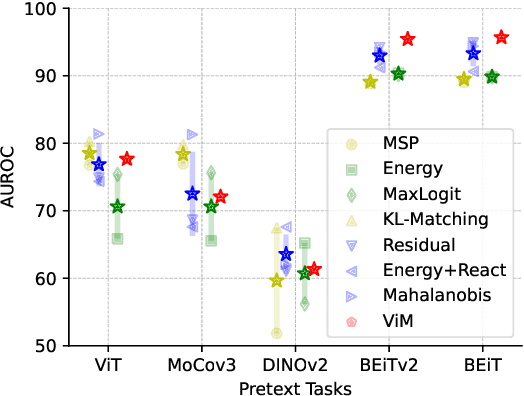
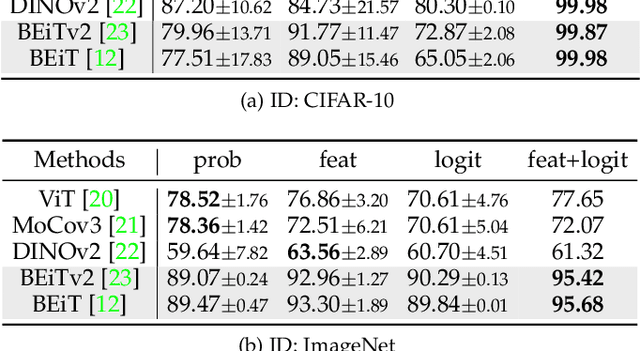
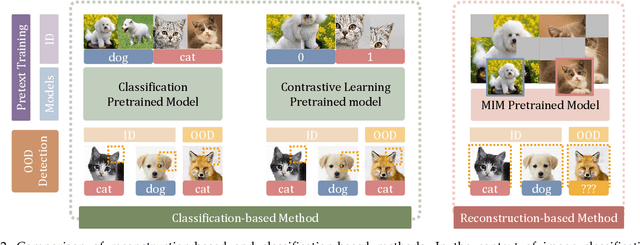
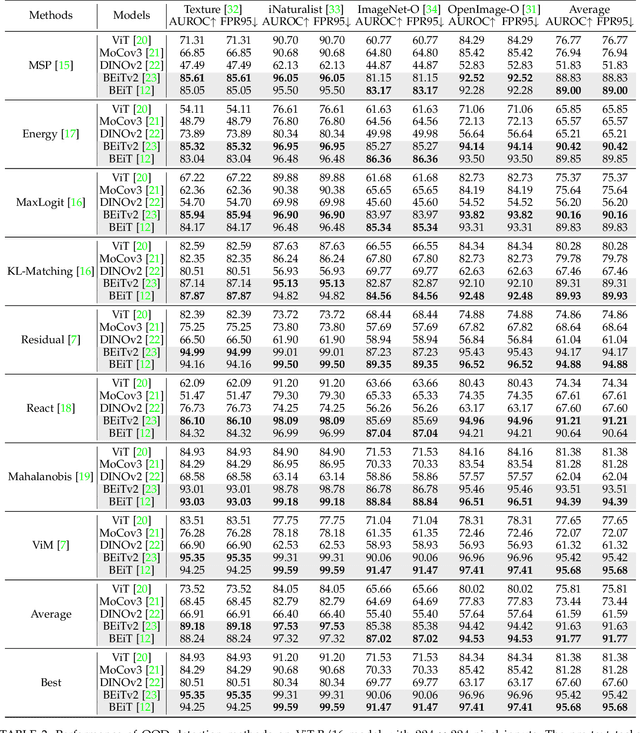
Abstract:The crux of effective out-of-distribution (OOD) detection lies in acquiring a robust in-distribution (ID) representation, distinct from OOD samples. While previous methods predominantly leaned on recognition-based techniques for this purpose, they often resulted in shortcut learning, lacking comprehensive representations. In our study, we conducted a comprehensive analysis, exploring distinct pretraining tasks and employing various OOD score functions. The results highlight that the feature representations pre-trained through reconstruction yield a notable enhancement and narrow the performance gap among various score functions. This suggests that even simple score functions can rival complex ones when leveraging reconstruction-based pretext tasks. Reconstruction-based pretext tasks adapt well to various score functions. As such, it holds promising potential for further expansion. Our OOD detection framework, MOODv2, employs the masked image modeling pretext task. Without bells and whistles, MOODv2 impressively enhances 14.30% AUROC to 95.68% on ImageNet and achieves 99.98% on CIFAR-10.
BAL: Balancing Diversity and Novelty for Active Learning
Dec 26, 2023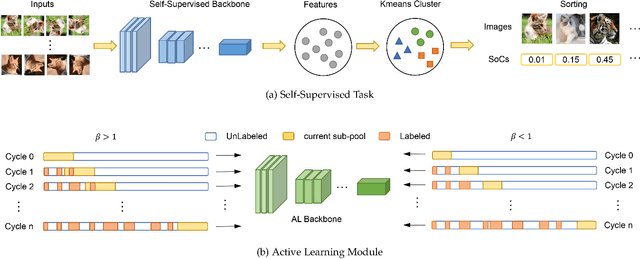
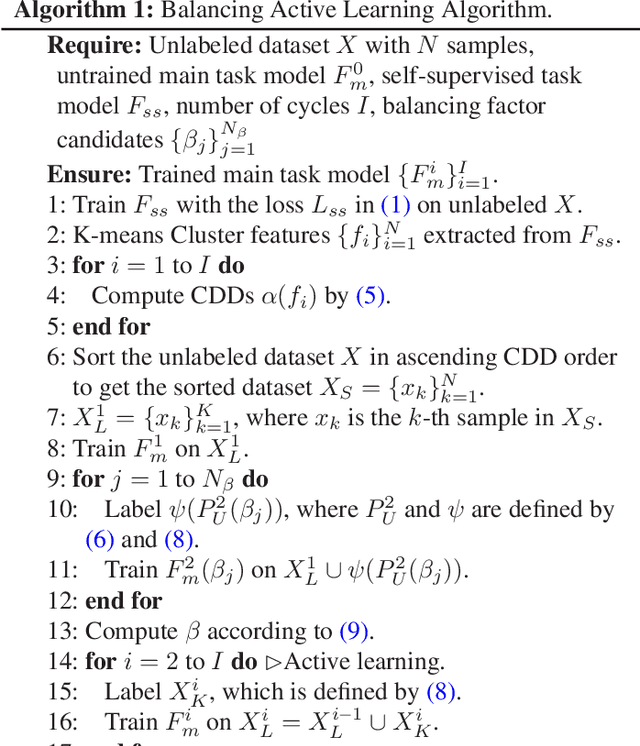

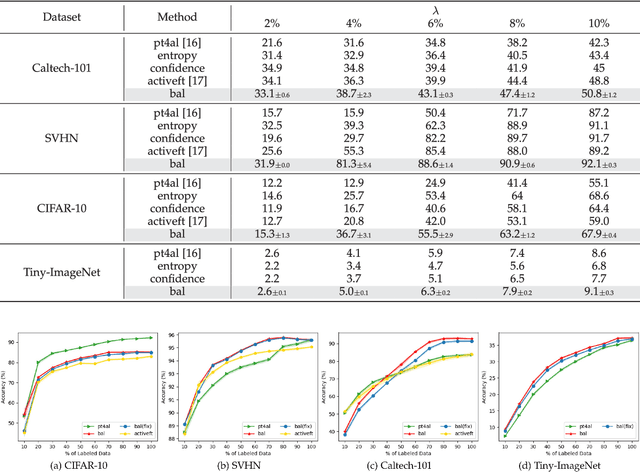
Abstract:The objective of Active Learning is to strategically label a subset of the dataset to maximize performance within a predetermined labeling budget. In this study, we harness features acquired through self-supervised learning. We introduce a straightforward yet potent metric, Cluster Distance Difference, to identify diverse data. Subsequently, we introduce a novel framework, Balancing Active Learning (BAL), which constructs adaptive sub-pools to balance diverse and uncertain data. Our approach outperforms all established active learning methods on widely recognized benchmarks by 1.20%. Moreover, we assess the efficacy of our proposed framework under extended settings, encompassing both larger and smaller labeling budgets. Experimental results demonstrate that, when labeling 80% of the samples, the performance of the current SOTA method declines by 0.74%, whereas our proposed BAL achieves performance comparable to the full dataset. Codes are available at https://github.com/JulietLJY/BAL.
OOD-CV-v2: An extended Benchmark for Robustness to Out-of-Distribution Shifts of Individual Nuisances in Natural Images
Apr 17, 2023



Abstract:Enhancing the robustness of vision algorithms in real-world scenarios is challenging. One reason is that existing robustness benchmarks are limited, as they either rely on synthetic data or ignore the effects of individual nuisance factors. We introduce OOD-CV-v2, a benchmark dataset that includes out-of-distribution examples of 10 object categories in terms of pose, shape, texture, context and the weather conditions, and enables benchmarking of models for image classification, object detection, and 3D pose estimation. In addition to this novel dataset, we contribute extensive experiments using popular baseline methods, which reveal that: 1) Some nuisance factors have a much stronger negative effect on the performance compared to others, also depending on the vision task. 2) Current approaches to enhance robustness have only marginal effects, and can even reduce robustness. 3) We do not observe significant differences between convolutional and transformer architectures. We believe our dataset provides a rich test bed to study robustness and will help push forward research in this area. Our dataset can be accessed from http://www.ood-cv.org/challenge.html
Rethinking Out-of-distribution (OOD) Detection: Masked Image Modeling is All You Need
Feb 06, 2023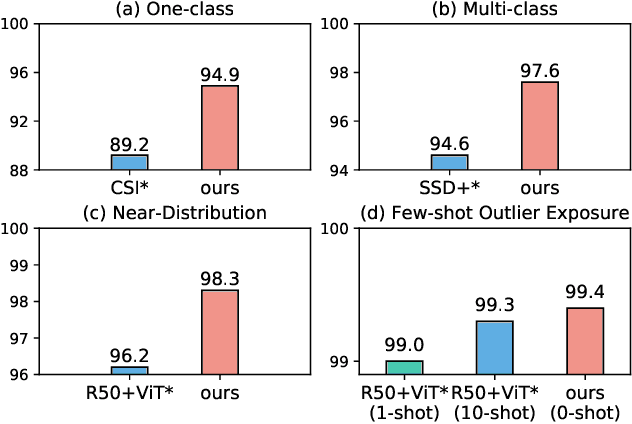

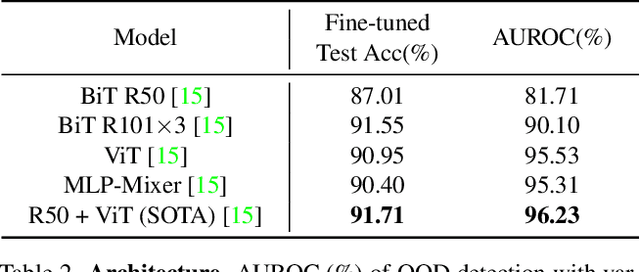
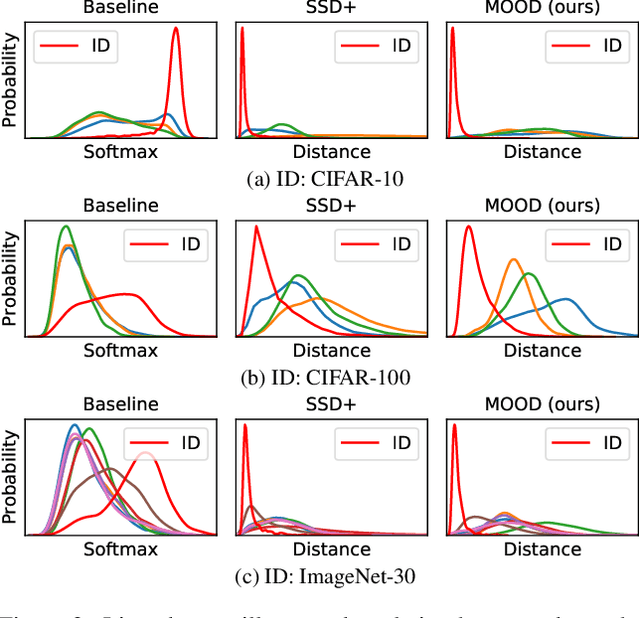
Abstract:The core of out-of-distribution (OOD) detection is to learn the in-distribution (ID) representation, which is distinguishable from OOD samples. Previous work applied recognition-based methods to learn the ID features, which tend to learn shortcuts instead of comprehensive representations. In this work, we find surprisingly that simply using reconstruction-based methods could boost the performance of OOD detection significantly. We deeply explore the main contributors of OOD detection and find that reconstruction-based pretext tasks have the potential to provide a generally applicable and efficacious prior, which benefits the model in learning intrinsic data distributions of the ID dataset. Specifically, we take Masked Image Modeling as a pretext task for our OOD detection framework (MOOD). Without bells and whistles, MOOD outperforms previous SOTA of one-class OOD detection by 5.7%, multi-class OOD detection by 3.0%, and near-distribution OOD detection by 2.1%. It even defeats the 10-shot-per-class outlier exposure OOD detection, although we do not include any OOD samples for our detection
ROBIN : A Benchmark for Robustness to Individual Nuisances in Real-World Out-of-Distribution Shifts
Dec 02, 2021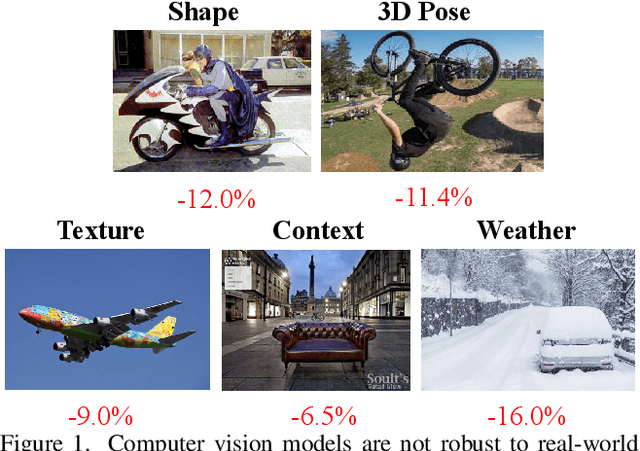
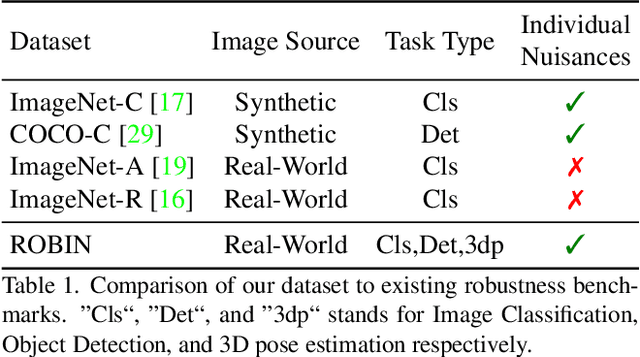


Abstract:Enhancing the robustness in real-world scenarios has been proven very challenging. One reason is that existing robustness benchmarks are limited, as they either rely on synthetic data or they simply measure robustness as generalization between datasets and hence ignore the effects of individual nuisance factors. In this work, we introduce ROBIN, a benchmark dataset for diagnosing the robustness of vision algorithms to individual nuisances in real-world images. ROBIN builds on 10 rigid categories from the PASCAL VOC 2012 and ImageNet datasets and includes out-of-distribution examples of the objects 3D pose, shape, texture, context and weather conditions. ROBIN is richly annotated to enable benchmark models for image classification, object detection, and 3D pose estimation. We provide results for a number of popular baselines and make several interesting observations: 1. Some nuisance factors have a much stronger negative effect on the performance compared to others. Moreover, the negative effect of an OODnuisance depends on the downstream vision task. 2. Current approaches to enhance OOD robustness using strong data augmentation have only marginal effects in real-world OOD scenarios, and sometimes even reduce the OOD performance. 3. We do not observe any significant differences between convolutional and transformer architectures in terms of OOD robustness. We believe our dataset provides a rich testbed to study the OOD robustness of vision algorithms and will help to significantly push forward research in this area.
Rail-5k: a Real-World Dataset for Rail Surface Defects Detection
Jun 28, 2021
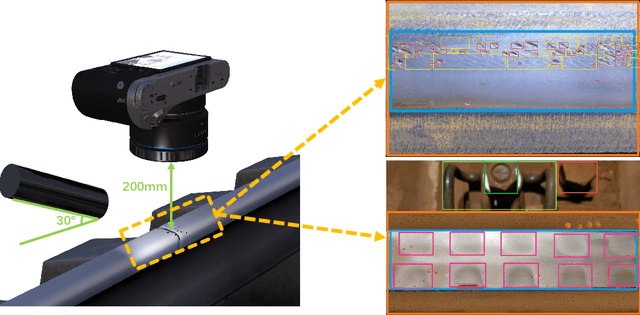
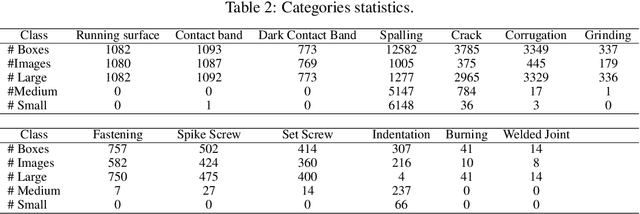

Abstract:This paper presents the Rail-5k dataset for benchmarking the performance of visual algorithms in a real-world application scenario, namely the rail surface defects detection task. We collected over 5k high-quality images from railways across China, and annotated 1100 images with the help from railway experts to identify the most common 13 types of rail defects. The dataset can be used for two settings both with unique challenges, the first is the fully-supervised setting using the 1k+ labeled images for training, fine-grained nature and long-tailed distribution of defect classes makes it hard for visual algorithms to tackle. The second is the semi-supervised learning setting facilitated by the 4k unlabeled images, these 4k images are uncurated containing possible image corruptions and domain shift with the labeled images, which can not be easily tackle by previous semi-supervised learning methods. We believe our dataset could be a valuable benchmark for evaluating robustness and reliability of visual algorithms.
Reducing the feature divergence of RGB and near-infrared images using Switchable Normalization
Jun 06, 2021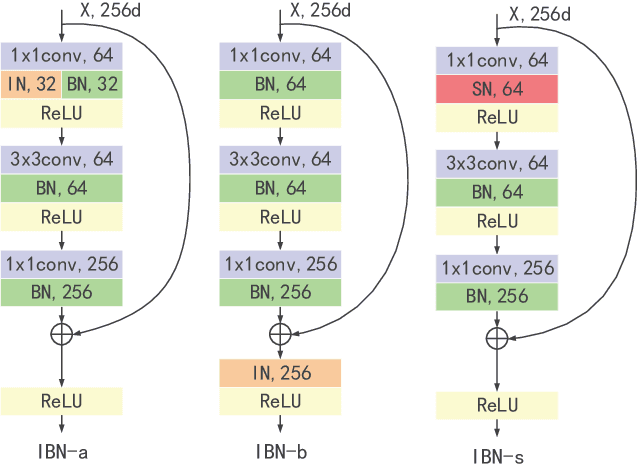
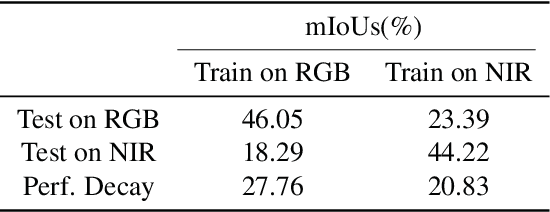
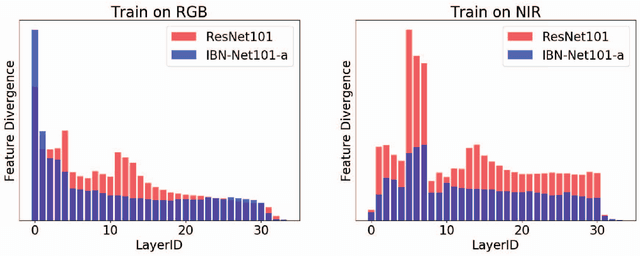
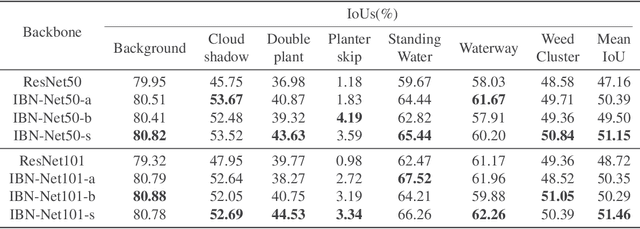
Abstract:Visual pattern recognition over agricultural areas is an important application of aerial image processing. In this paper, we consider the multi-modality nature of agricultural aerial images and show that naively combining different modalities together without taking the feature divergence into account can lead to sub-optimal results. Thus, we apply a Switchable Normalization block to our DeepLabV3 segmentation model to alleviate the feature divergence. Using the popular symmetric Kullback Leibler divergence measure, we show that our model can greatly reduce the divergence between RGB and near-infrared channels. Together with a hybrid loss function, our model achieves nearly 10\% improvements in mean IoU over previously published baseline.
 Add to Chrome
Add to Chrome Add to Firefox
Add to Firefox Add to Edge
Add to Edge